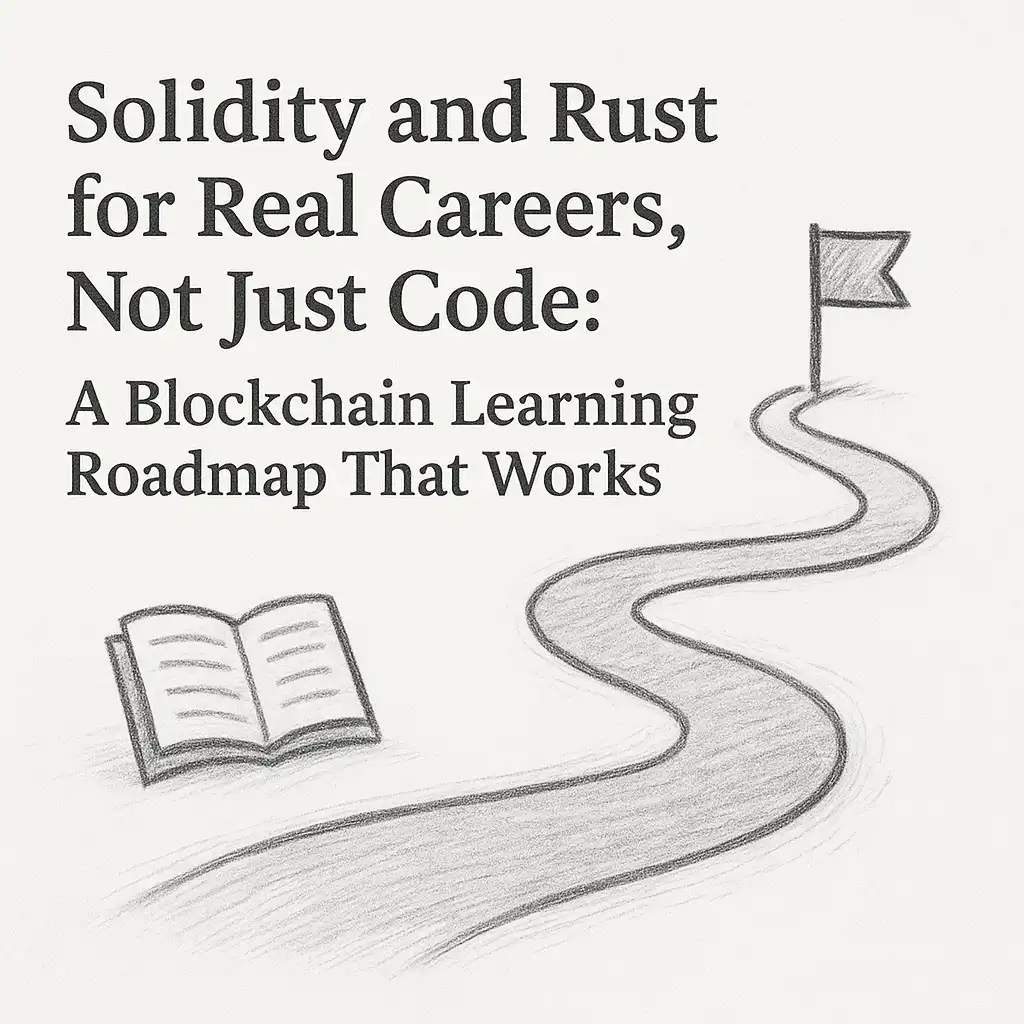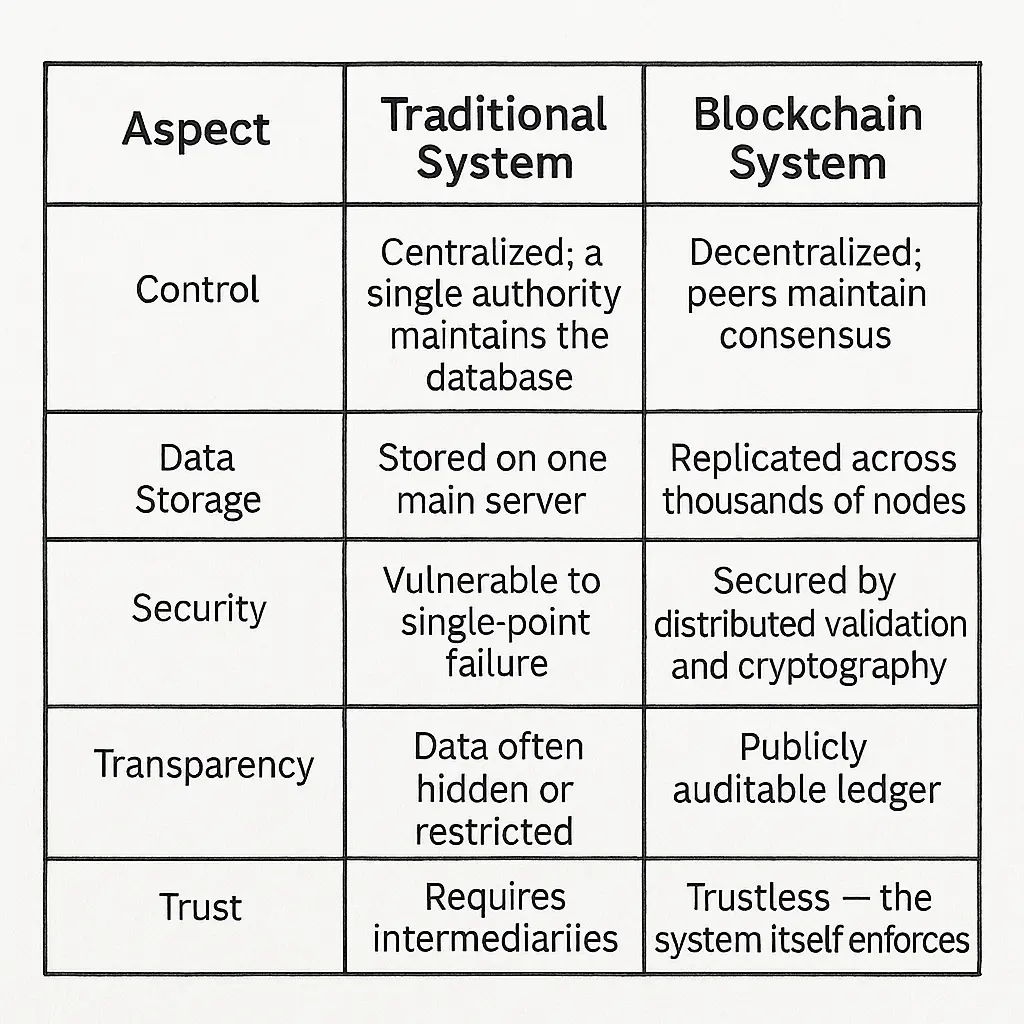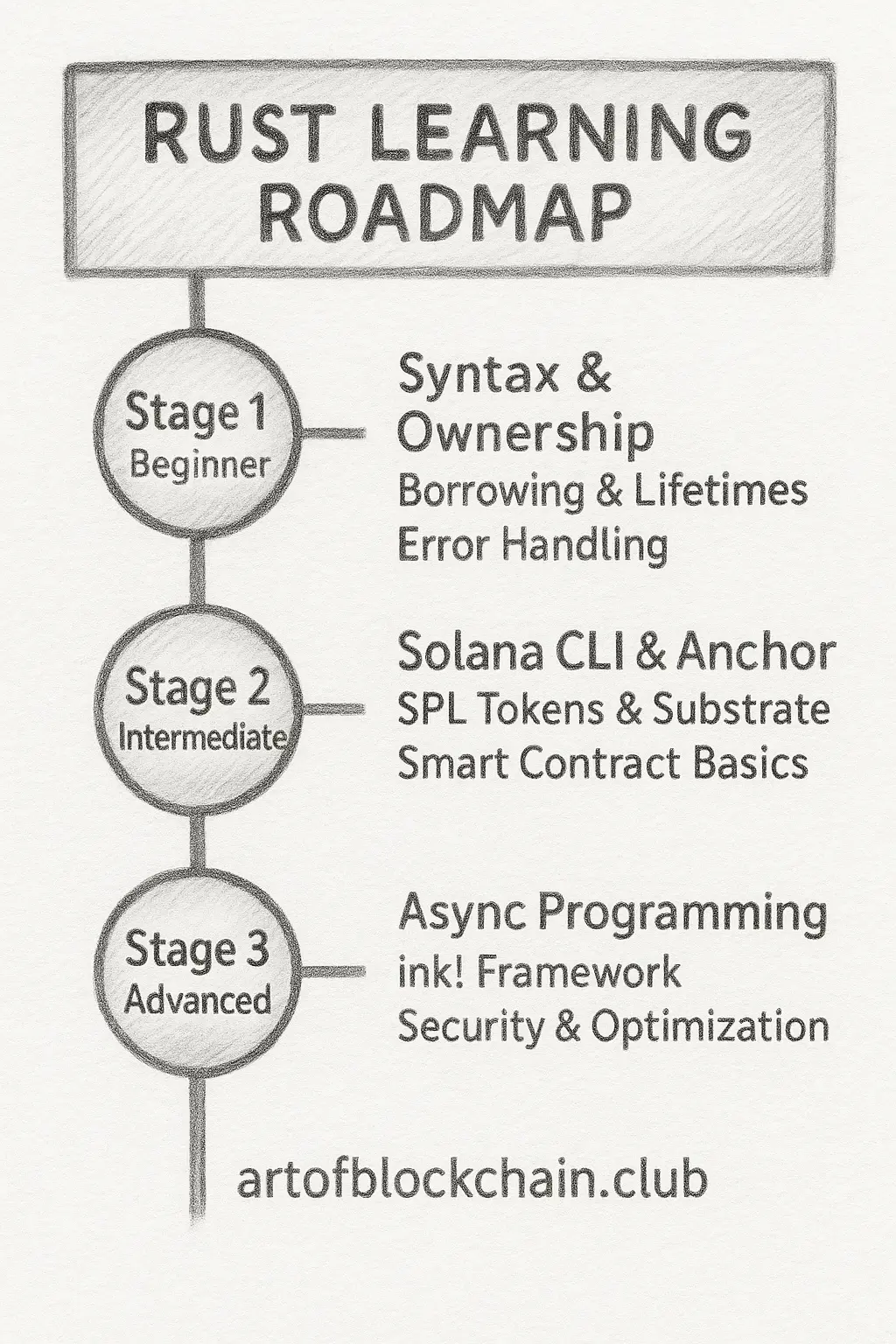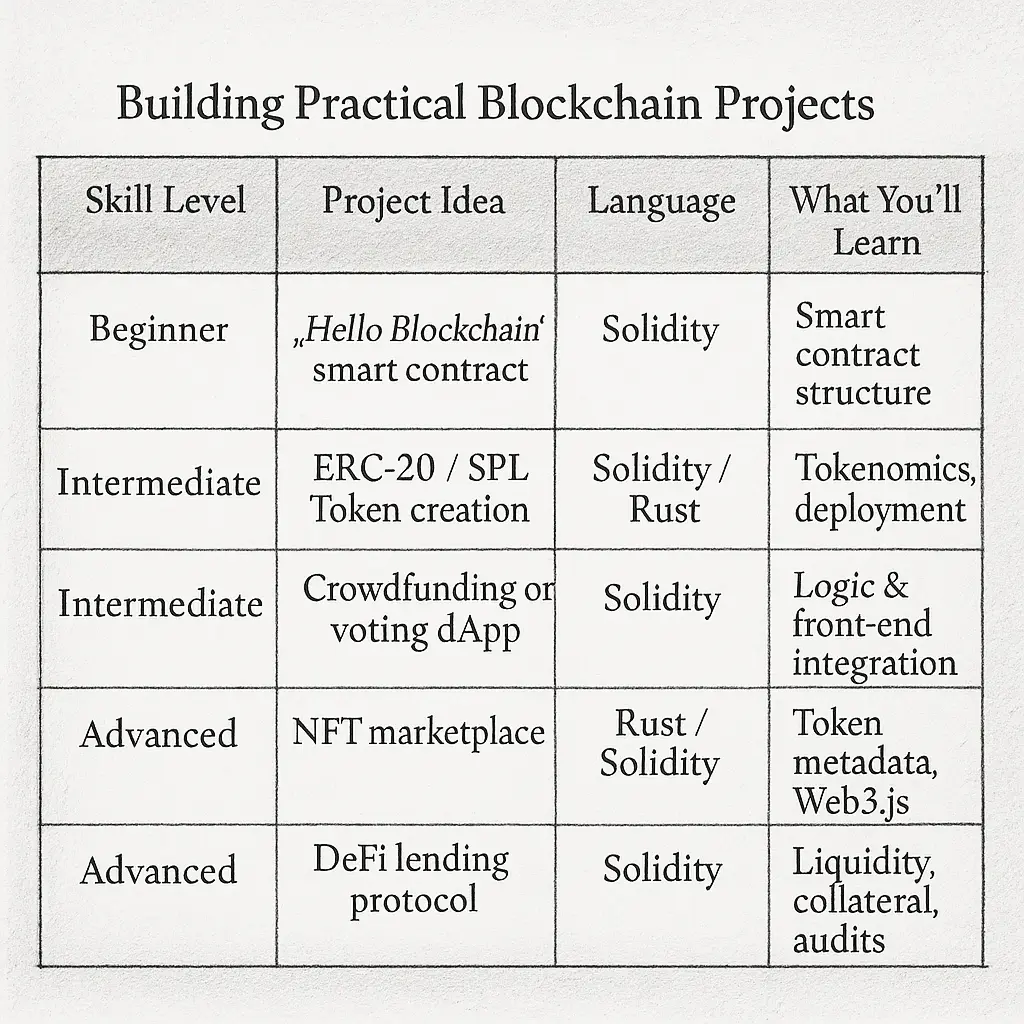Solidity and Rust for Real Careers, Not Just Code: A Blockchain Learning Roadmap That Works

If you’ve ever wondered how to learn blockchain (Rust, Solidity) and build a lasting career in Web3, you’re not alone. Thousands of developers are leaving Web 2.0 stacks to master decentralized programming — but the learning curve can feel confusing and scattered.
This guide from ArtofBlockchain.club lays out a single, reliable roadmap that takes you from zero to professional-level blockchain developer. Whether you’re a student or a junior programmer, you’ll find a clear path to mastering both Rust and Solidity, the two languages powering networks like Ethereum, Solana, and Polkadot.
What Exactly Is Blockchain — and Why It Matters
At its core, blockchain is a distributed ledger, a decentralized record of transactions stored across many computers. Instead of a single authority controlling the database, all nodes verify and agree on each transaction using a consensus mechanism. This makes blockchain systems transparent, immutable, and nearly impossible to tamper with.
Developers are drawn to this technology because it eliminates intermediaries, builds trust through code, and enables smart contracts — the backbone of decentralized applications, or dApps.
A solid grasp of blockchain fundamentals sets the stage for everything else you’ll build, from NFT marketplaces to decentralized finance (DeFi) platforms.
How Blockchain Differs from Traditional Systems
Understanding what makes blockchain revolutionary begins with comparing it to traditional client-server systems:

For a deeper technical explanation, check out our internal primer on how consensus mechanisms work.
Core Concepts Every Developer Must Know
Before you touch Rust or Solidity, familiarize yourself with these fundamental blockchain components:
Smart Contracts: Self-executing pieces of code that live on the blockchain. Our introduction to smart contracts explains how they automate transactions without intermediaries.
Consensus Algorithms: Rules determining how the network agrees on valid transactions. Common models include Proof of Work, Proof of Stake, and Delegated Proof of Stake.
Gas Fees: The cost of computation on networks like Ethereum. Learn how to optimize gas usage to make your dApps efficient.
Nodes and Validators: The backbone of any blockchain — computers that store data and verify blocks.
Wallets and Keys: Understanding private vs. public keys is essential; see our beginner explainer on blockchain wallets and digital signatures.
These ideas form the mental model for everything you’ll build later, from your first token to advanced cross-chain bridges.
Why Learning Rust and Solidity Matters
Two languages dominate modern blockchain development — Solidity and Rust — each opening doors to different ecosystems and job markets.
Solidity — The Language of Ethereum and Smart Contracts
Solidity powers the Ethereum Virtual Machine (EVM), enabling developers to write the smart contracts that define decentralized exchanges, governance systems, and NFT standards like ERC-20 and ERC-721.
Its C-like syntax makes it approachable for those familiar with JavaScript or C++. Through frameworks like Hardhat and Truffle, developers can quickly deploy and test smart contracts.
Rust — The Powerhouse Behind Solana and Polkadot
Rust is known for its speed, safety, and memory efficiency. It’s used to build high-performance blockchains like Solana, NEAR, and Polkadot, where throughput and scalability are critical.
Rust’s strict ownership model prevents many runtime errors that plague other languages. Though challenging at first, mastering it can lead to high-paying, low-competition roles. For a gentle start, see our community-favorite guide, Rust for Blockchain Beginners, which explains ownership, borrowing, and lifetimes with blockchain examples.
💡 Pro tip: Developers proficient in Rust and Solidity are in the top 5 % of the Web3 job market — bridging application-level and protocol-level development.
At this stage, you’ve gained conceptual clarity on what blockchain is, how it works, and why Rust + Solidity are worth learning.
Next, we’ll move from concept to execution — setting up your tools and beginning your first smar contract journey.
The Practical Roadmap to Mastering Solidity and Rust
After grasping blockchain fundamentals, it’s time to start building. In this phase, you’ll move from theory to hands-on development — setting up your environment, learning Solidity and Rust step by step, and creating your first real blockchain projects.
Whether your goal is to write your first Ethereum smart contract or build scalable applications on Solana, this roadmap will help you learn efficiently while avoiding beginner mistakes.

Laying the Foundation Before You Code
Before diving into smart contracts, it’s essential to strengthen your technical foundation. Blockchain rewards developers who understand both the “why” and “how” behind what they’re coding.
If you already know JavaScript or C++, great — those skills transfer directly into Solidity’s syntax and logic. For Rust, having prior experience with systems languages helps, but even beginners can succeed with consistent practice.
You should focus on three key fundamentals:
Programming Essentials:
Refresh your knowledge of object-oriented programming, data structures, and version control with Git. If you’re coming from a web background, check out our transition guide for web developers entering blockchain.Cryptography Basics:
Learn the concepts of hashing, digital signatures, and public-private key encryption, which secure blockchain systems. Our community post on hashing and consensus algorithms explained offers a beginner-friendly breakdown.Blockchain Architecture:
Study how nodes, validators, and smart contracts communicate within decentralized networks. To visualize this, explore our article on blockchain architecture and data flow.
When you understand these building blocks, writing your first smart contract becomes much less intimidating.
Setting Up Your Blockchain Developer Toolkit
Just like a mechanic needs the right tools to build engines, blockchain developers rely on specialized frameworks and wallets to deploy and test their code.
Let’s go over the must-haves for your developer setup:
MetaMask: Browser wallet used for connecting to testnets and interacting with dApps.
Remix IDE: A web-based IDE ideal for experimenting with Solidity contracts in real-time.
Hardhat and Truffle: Frameworks for professional-grade Ethereum development, testing, and debugging.
Ganache: Local blockchain simulator for safe, offline experimentation.
Solana CLI: Command-line interface for deploying Rust-based Solana programs.
Anchor Framework: Solana’s equivalent of Truffle — simplifies smart contract creation in Rust.
Substrate Framework: For building entire blockchains using Rust under the Polkadot ecosystem.
If you’re new to setup processes, read our full Blockchain Developer Setup Guide, which walks through installing and configuring each of these tools.
Learning Solidity Step by Step
Solidity remains the gateway into blockchain development, especially for those interested in Ethereum, Polygon, or Binance Smart Chain.
The roadmap below breaks down your journey into three stages, guiding you from absolute beginner to deployment-ready smart contract engineer.
Stage 1: Beginner — Writing Your First Smart Contracts
Start with the basics: defining contracts, understanding data types, and using functions. You can use Remix IDE to write and deploy your first “Hello Blockchain” contract.
Beginner-friendly milestones include:
Declaring variables, arrays, and mappings.
Using visibility modifiers (public, private, external).
Creating events and emitting logs.
We also recommend trying CryptoZombies, a gamified way to learn Solidity by building a zombie-themed smart contract.
For in-depth reading, see our internal guide: Solidity Syntax and Smart Contract Basics Explained.
Stage 2: Intermediate — Deployment, Testing, and Optimization
Once you can write basic contracts, move into real-world deployment using Hardhat or Truffle. This is where most developers start feeling like professionals.
You’ll learn to:
Deploy contracts on Ethereum Testnets like Goerli or Sepolia.
Write test scripts in JavaScript or TypeScript.
Debug errors using Hardhat console.
Analyze gas consumption and optimize code.
Try deploying an ERC-20 token or a voting dApp on a testnet. We’ve got a practical walkthrough for this in our Deploying Smart Contracts on Goerli Network tutorial.
Stage 3: Advanced — Security and Smart Contract Auditing
Once you’re comfortable with deployments, it’s time to learn security, the most valuable skill in blockchain. Even small vulnerabilities can cost millions.
Focus on:
Reentrancy attacks and integer overflows
Access control flaws and unchecked external calls
Using OpenZeppelin libraries for trusted, secure templates
We’ve covered this topic in detail in our internal resource: Smart Contract Security Checklist.
Also, explore Mythril and Slither — popular tools for analyzing vulnerabilities automatically.
Learning Rust Step by Step
If Solidity represents blockchain’s “frontline,” Rust is its engine room — powering networks like Solana, NEAR, and Polkadot that demand speed and reliability.
Rust may have a steeper learning curve, but it pays off with stronger job prospects and deeper understanding of blockchain internals.

Stage 1: Beginner — Getting Comfortable with Rust
Start with The Rust Programming Language Book and complement it with interactive exercises via Rustlings.
At this stage, your goal is to understand:
Ownership and borrowing (Rust’s most important concept)
Lifetimes and error handling using Result and Option
Pattern matching and control flow
Our detailed internal tutorial, Learning Rust for Blockchain Development, will help you tie these concepts directly to Web3 applications.
Stage 2: Intermediate — Building Real Blockchain Projects
Now it’s time to build. Install the Solana CLI and explore Anchor Framework. These tools simplify deploying Rust-based programs (smart contracts) to Solana clusters.
You can start by:
Creating a SPL token (Solana’s version of ERC-20).
Building a voting dApp on Solana Devnet.
Experimenting with accounts and program IDs.
For those drawn to Polkadot, explore the Substrate Developer Hub to learn how to create custom blockchains using modular components.
Stage 3: Advanced — Scaling, Concurrency, and Security
At this level, you’ll refine your ability to build scalable, secure, and high-performance programs. Learn about:
Asynchronous programming (async/await)
Multithreading
Smart contract patterns in Anchor and ink!
We suggest exploring Advanced Rust Programming Concepts — a deep-dive guide from our forum focused specifically on blockchain optimization and security.
Building Practical Blockchain Projects

Theory becomes skill through practice. Here are projects that gradually build real-world experience:
You can find detailed walkthroughs for several of these inside our internal Blockchain Project Tutorials Hub.
Join the Community and Keep Building
The blockchain space evolves faster than any other technology. Staying connected to the right communities ensures you grow with it.
Here are our top recommendations:
Discord: Join official Ethereum, Solana, and Rust servers.
GitHub: Follow open-source projects like OpenZeppelin or Solana Labs.
Reddit: Active subreddits like r/ethdev and r/solana.
Forums: Participate in peer learning via the ArtofBlockchain Forum.
At this point, you’ve installed your tools, written your first smart contracts, and explored Rust programming on Solana. You’re now equipped with the technical foundation to move toward career applications and professional growth, which we’ll explore in the next phase.
From Learning to Earning — Building a Career in Blockchain Development
Congratulations — if you’ve reached this stage, you already know more than most beginners in blockchain. You understand the fundamentals, you’ve practiced Solidity and Rust, and you’ve probably written a few small dApps or deployed a testnet token.
Now, it’s time to turn your knowledge into career capital. Whether your goal is to become a smart contract developer, blockchain engineer, or auditor, this phase will help you build consistency, showcase your skills, and land opportunities in the Web3 space.
Read our career guides for these job roles
https://artofblockchain.club/article/how-to-become-a-blockchain-engineer-complete-guide
https://artofblockchain.club/article/smart-contract-audits-your-codes-essential-security-check
Overcoming Common Challenges in Blockchain Learning
Learning blockchain isn’t linear. You’ll face moments of confusion, frustration, and doubt — especially when debugging your first Solidity or Rust programs. But every professional developer started there.
Let’s tackle the most common obstacles you’ll encounter — and how to overcome them.
1. The Overload Problem
With thousands of tutorials, YouTube videos, and conflicting blog posts, it’s easy to get lost.
The best solution is structured learning. Follow a defined progression like the one in our Blockchain Developer Roadmap 2025, which guides learners step-by-step from beginner to job-ready.
Focus on one ecosystem at a time:
Begin with Solidity and Ethereum-based tools.
Move to Rust and Solana once you’ve mastered EVM fundamentals.
2. The Rust Learning Curve
Rust is one of the toughest languages for beginners — but it rewards persistence. Its compiler teaches you to write safe, efficient code.
If you ever feel stuck, read our post on How to Overcome Rust’s Ownership Challenges. You’ll learn why those “annoying” compiler messages are actually your best teachers.
3. Staying Consistent in Learning
Consistency beats intensity. Instead of coding for 10 hours once a week, dedicate one focused hour daily.
To build accountability, join peer groups like our Blockchain Learners Discord Community where developers share progress and projects weekly.
Avoiding Burnout and Building Momentum
Burnout is real — especially in blockchain, where the pace of innovation never stops. To sustain long-term growth, balance learning, building, and resting.
Alternate between reading theory and building small projects.
Journal your progress weekly — even short reflections reinforce learning.
Reward yourself when you deploy your first project or contribute to open-source.
If you ever feel demotivated, revisit stories from our Blockchain Career Success Series, where developers share how they started with no experience and now work full-time in Web3.
💡 Motivation fades, but habits compound. Build steady learning routines, not sprints.
Blockchain Career Paths and Opportunities
One of blockchain’s greatest strengths is its diversity of roles. You don’t have to become a “Solidity wizard” to build a career — the industry values engineers, researchers, front-end developers, auditors, and even writers who understand blockchain deeply.
Here are the most in-demand paths:
1. Smart Contract Developer
You’ll write and deploy contracts in Solidity or Rust to power dApps, DeFi systems, or NFT projects.
For insights, check our article on Smart Contract Developer Skills in 2025.
Average salary range: $90,000 – $160,000 USD/year
2. Blockchain Protocol Engineer
You’ll work on the core layer of blockchain networks — designing consensus algorithms, optimizing performance, and maintaining validator software.
Rust dominates here, especially in Solana and Polkadot ecosystems.
Average salary range: $120,000 – $180,000 USD/year
3. Blockchain Auditor or Security Researcher
Security is the most lucrative and respected niche in blockchain. Auditors analyze smart contracts for vulnerabilities before deployment.
Average salary range: $100,000 – $200,000 USD/year
4. Web3 Front-End Developer
If you enjoy combining UI and blockchain logic, this role’s for you. You’ll use React, Next.js, and Web3.js or Ethers.js to build interfaces that connect users to smart contracts.
Average salary range: $70,000 – $130,000 USD/year
How to Build a Blockchain Developer Portfolio
In blockchain, your GitHub is your résumé. Employers don’t want to see degrees — they want to see code that works on testnets, projects that solve real problems, and community engagement.
Here’s how to create a portfolio that impresses recruiters and DAO leaders alike:
Start Public: Even beginner projects showcase initiative. Share your first contract deployment as a blog post.
Contribute to Open Source: Many repositories, like OpenZeppelin and Solana Labs, mark “good first issues.”
Create a Showcase Site: Use Notion or GitHub Pages to display your projects.
Add Case Studies: Write about what you built and the lessons learned.
Example: My Journey Building a Voting dApp.Join Hackathons: Platforms like ETHGlobal and Encode Club are great places to network and gain exposure.
For deeper tips, visit our complete Blockchain Developer Portfolio Guide.
The Future of Blockchain Development
The blockchain industry is moving fast — from DeFi to AI-integrated protocols, the next five years will redefine how developers build and users interact.
Here are key trends shaping the future:
Layer-2 Rollups: Developers skilled in Solidity and zero-knowledge proofs are in high demand.
Cross-chain Interoperability: Rust devs are driving bridges that connect multiple networks.
Decentralized Identity (DID): A growing sector merging privacy, cryptography, and social apps.
AI and Blockchain Fusion: AI models are being deployed on decentralized networks for verifiable computation.
For in-depth analysis, see our insight post — The Future of Blockchain Jobs in 2025 and Beyond.
FAQs About Learning Blockchain (Rust, Solidity)
1. How long does it take to become a blockchain developer?
With consistent learning and project work, expect around 4–6 months to reach job-ready competence. Our How to Become a Blockchain Developer After 12th? provides a structured plan.
2. Should I start with Rust or Solidity?
Start with Solidity — it’s simpler and gives quick results on Ethereum and EVM-compatible chains. Once you’re comfortable, move to Rust for high-performance ecosystems like Solana and Polkadot.
You can follow this progression in our How to learn Ethereum, Crypto & Blockchain Basics to Build a Web3 Career
3. What tools do I need to start?
You’ll mainly need Remix IDE, Hardhat, and MetaMask for Solidity, and Solana CLI plus Anchor for Rust.
Read our discussion threads around “tools”
Can Smart Contracts Be Audited? What Are the Common Tools for Auditing?
How to switch to blockchain testing? Key skills, tools, and career scope?
How to Switch from Data Analyst to DAO Analyst: Skills, Tools, and First Steps
4. Are blockchain jobs still in demand?
Yes — blockchain roles continue to grow. Companies are actively hiring Solidity and Rust developers in DeFi, gaming, and infrastructure.
Explore current openings on our Blockchain Jobs Board.
5. Can I practice blockchain projects for free?
Absolutely. Use testnets like Goerli (Ethereum) or Devnet (Solana). We’ve covered how to deploy safely using faucet tokens in our Deploy on Testnet Tutorial.
6. How can I prepare for blockchain job interviews?
Review your projects and understand the “why” behind your code. Practice common Solidity and Rust interview questions from our Blockchain Developer Interview Guide. Go to search bar on artofblockchain.club and search interview and enjoy your learnings.
7. What are the highest-paying blockchain roles?
Blockchain protocol engineers and security auditors tend to earn the most — often exceeding $180,000 USD/year.
Conclusion: Your Blockchain Career Starts Now
Learning blockchain development isn’t just about syntax — it’s about joining a movement that’s redefining the digital economy.
By mastering Rust and Solidity, you’re not only learning two in-demand languages — you’re future-proofing your career in a trillion-dollar ecosystem.
You now have a complete roadmap:
From blockchain fundamentals →
To hands-on coding and projects →
To career strategy and job preparation.
If you stay consistent, contribute to open source, and keep experimenting, you’ll soon find yourself building the next wave of decentralized innovation.
✨ Start today. The Web3 world isn’t waiting — it’s being built by learners like you.